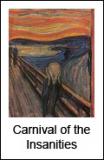 Given time, many expect the Iranian theocracy to crumble. There are too many faultlines in the society - the economy, jobs, and indeed, there is a signficant waning in religiosity as Iranians, particularly younger Iranians, become cynical of their government. Indeed, it is the faultlines in Iranian society that augur most against attakcing Iran over the nuclear issue unless there is no other choice.
Given time, many expect the Iranian theocracy to crumble. There are too many faultlines in the society - the economy, jobs, and indeed, there is a signficant waning in religiosity as Iranians, particularly younger Iranians, become cynical of their government. Indeed, it is the faultlines in Iranian society that augur most against attakcing Iran over the nuclear issue unless there is no other choice.
This is from an article today in the Boston Review:
Modern Iran has consistently wobbled between the dual and sometimes conflicting pillars that define it: Islam, and what is now euphemistically called Iran’s “pre-Islamic heritage.” As Iran struggles to emerge from the oppressive failures of its Islamic revolution, it has grown increasingly conscious of its roots.
Despite Iran’s reputation as the harbinger of Islamic revolution, the simple fact is that Iranians never wanted an Islamic state in the way Ayatollahs Ruhollah Khomeini and Ali Khamenei have forged it. Many Iranians welcomed the re-emergence of religion in Iran after the Shah’s relentless modernism, but few wanted or expected the clerics to grab control over people’s daily lives and government.
While in most Sunni Arab countries matters of religion and state have always been inextricable, Iran’s Shi‘ite society sought to separate them. Shi‘ite clerics traditionally belonged to three schools of political thought—“loyalists” who believed in cooperation with the state, “opposers” who exercised moral suasion on the political process from the outside, and “quietists” who advocated outright withdrawal from politics. Before Khomeini, the latter were the largest group.
Khomeini introduced a radically new principle into Shi‘ite Islam: velayat-e faqih (or direct rule by the most senior cleric, i.e., himself). This novel doctrine progressively alienated Iranians and created deep divisions within the clergy, as in the current rift between the hard-line clerics led by Iran’s current Supreme Leader Khamenei (the new beneficiary of velayat-e faqih) and the reformers led by President Hojjatoleslam (the rank just below Ayatollah) Mohammad Khatami.
It is this Shi‘ite tradition of interpretive Islam and political freedom that is causing Iranians to chafe under Khamenei’s velayat-e faqih and giving rise to political changes that could produce the first and most sustainable democracy in the Middle East.
“A loss of faith with the mullahs [in government] has led to a loss of faith in the religion,” says Azar Bharami, a lawyer and women’s rights activist in Tehran. “When the government does not respect the [line] between religion and state how can people?” Numerous surveys, including one by the magazine Asr-e Ma (“Our Era”), have shown that most Iranians under the age of 25—who make up 50 percent of the overall population—consider themselves agnostic. Many young Iranians are cynical, even derisive, about their religion. Epithets like “mad mullahs” and “this thing Islam” are not uncommon.
I do truly hope that the "mad mullahs" do not force the hand of the West before Iran's experiment in theocracy can crash of its own corrupt weight.



No comments:
Post a Comment